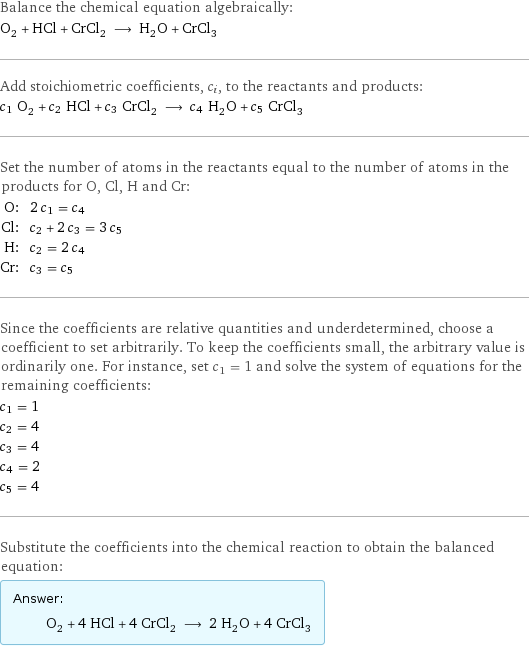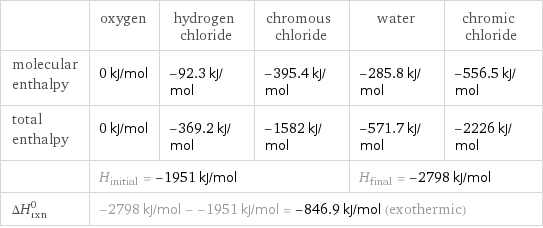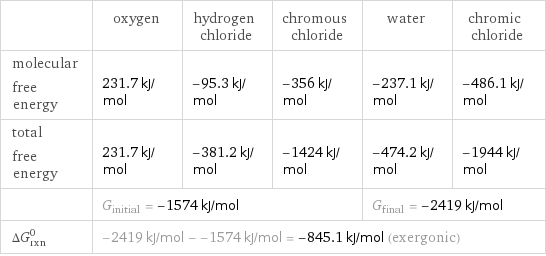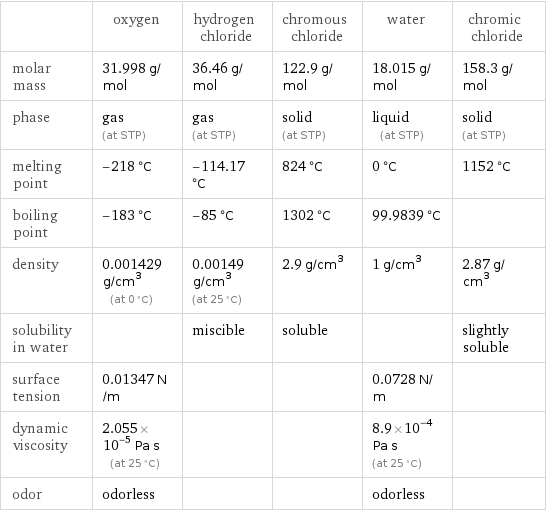Input interpretation

O_2 oxygen + HCl hydrogen chloride + CrCl_2 chromous chloride ⟶ H_2O water + CrCl_3 chromic chloride
Balanced equation

Balance the chemical equation algebraically: O_2 + HCl + CrCl_2 ⟶ H_2O + CrCl_3 Add stoichiometric coefficients, c_i, to the reactants and products: c_1 O_2 + c_2 HCl + c_3 CrCl_2 ⟶ c_4 H_2O + c_5 CrCl_3 Set the number of atoms in the reactants equal to the number of atoms in the products for O, Cl, H and Cr: O: | 2 c_1 = c_4 Cl: | c_2 + 2 c_3 = 3 c_5 H: | c_2 = 2 c_4 Cr: | c_3 = c_5 Since the coefficients are relative quantities and underdetermined, choose a coefficient to set arbitrarily. To keep the coefficients small, the arbitrary value is ordinarily one. For instance, set c_1 = 1 and solve the system of equations for the remaining coefficients: c_1 = 1 c_2 = 4 c_3 = 4 c_4 = 2 c_5 = 4 Substitute the coefficients into the chemical reaction to obtain the balanced equation: Answer: | | O_2 + 4 HCl + 4 CrCl_2 ⟶ 2 H_2O + 4 CrCl_3
Structures

+ + ⟶ +
Names

oxygen + hydrogen chloride + chromous chloride ⟶ water + chromic chloride
Reaction thermodynamics
Enthalpy

| oxygen | hydrogen chloride | chromous chloride | water | chromic chloride molecular enthalpy | 0 kJ/mol | -92.3 kJ/mol | -395.4 kJ/mol | -285.8 kJ/mol | -556.5 kJ/mol total enthalpy | 0 kJ/mol | -369.2 kJ/mol | -1582 kJ/mol | -571.7 kJ/mol | -2226 kJ/mol | H_initial = -1951 kJ/mol | | | H_final = -2798 kJ/mol | ΔH_rxn^0 | -2798 kJ/mol - -1951 kJ/mol = -846.9 kJ/mol (exothermic) | | | |
Gibbs free energy

| oxygen | hydrogen chloride | chromous chloride | water | chromic chloride molecular free energy | 231.7 kJ/mol | -95.3 kJ/mol | -356 kJ/mol | -237.1 kJ/mol | -486.1 kJ/mol total free energy | 231.7 kJ/mol | -381.2 kJ/mol | -1424 kJ/mol | -474.2 kJ/mol | -1944 kJ/mol | G_initial = -1574 kJ/mol | | | G_final = -2419 kJ/mol | ΔG_rxn^0 | -2419 kJ/mol - -1574 kJ/mol = -845.1 kJ/mol (exergonic) | | | |
Equilibrium constant
![Construct the equilibrium constant, K, expression for: O_2 + HCl + CrCl_2 ⟶ H_2O + CrCl_3 Plan: • Balance the chemical equation. • Determine the stoichiometric numbers. • Assemble the activity expression for each chemical species. • Use the activity expressions to build the equilibrium constant expression. Write the balanced chemical equation: O_2 + 4 HCl + 4 CrCl_2 ⟶ 2 H_2O + 4 CrCl_3 Assign stoichiometric numbers, ν_i, using the stoichiometric coefficients, c_i, from the balanced chemical equation in the following manner: ν_i = -c_i for reactants and ν_i = c_i for products: chemical species | c_i | ν_i O_2 | 1 | -1 HCl | 4 | -4 CrCl_2 | 4 | -4 H_2O | 2 | 2 CrCl_3 | 4 | 4 Assemble the activity expressions accounting for the state of matter and ν_i: chemical species | c_i | ν_i | activity expression O_2 | 1 | -1 | ([O2])^(-1) HCl | 4 | -4 | ([HCl])^(-4) CrCl_2 | 4 | -4 | ([CrCl2])^(-4) H_2O | 2 | 2 | ([H2O])^2 CrCl_3 | 4 | 4 | ([CrCl3])^4 The equilibrium constant symbol in the concentration basis is: K_c Mulitply the activity expressions to arrive at the K_c expression: Answer: | | K_c = ([O2])^(-1) ([HCl])^(-4) ([CrCl2])^(-4) ([H2O])^2 ([CrCl3])^4 = (([H2O])^2 ([CrCl3])^4)/([O2] ([HCl])^4 ([CrCl2])^4)](../image_source/f945d6c7a438f2d69e70220fde664b86.png)
Construct the equilibrium constant, K, expression for: O_2 + HCl + CrCl_2 ⟶ H_2O + CrCl_3 Plan: • Balance the chemical equation. • Determine the stoichiometric numbers. • Assemble the activity expression for each chemical species. • Use the activity expressions to build the equilibrium constant expression. Write the balanced chemical equation: O_2 + 4 HCl + 4 CrCl_2 ⟶ 2 H_2O + 4 CrCl_3 Assign stoichiometric numbers, ν_i, using the stoichiometric coefficients, c_i, from the balanced chemical equation in the following manner: ν_i = -c_i for reactants and ν_i = c_i for products: chemical species | c_i | ν_i O_2 | 1 | -1 HCl | 4 | -4 CrCl_2 | 4 | -4 H_2O | 2 | 2 CrCl_3 | 4 | 4 Assemble the activity expressions accounting for the state of matter and ν_i: chemical species | c_i | ν_i | activity expression O_2 | 1 | -1 | ([O2])^(-1) HCl | 4 | -4 | ([HCl])^(-4) CrCl_2 | 4 | -4 | ([CrCl2])^(-4) H_2O | 2 | 2 | ([H2O])^2 CrCl_3 | 4 | 4 | ([CrCl3])^4 The equilibrium constant symbol in the concentration basis is: K_c Mulitply the activity expressions to arrive at the K_c expression: Answer: | | K_c = ([O2])^(-1) ([HCl])^(-4) ([CrCl2])^(-4) ([H2O])^2 ([CrCl3])^4 = (([H2O])^2 ([CrCl3])^4)/([O2] ([HCl])^4 ([CrCl2])^4)
Rate of reaction
![Construct the rate of reaction expression for: O_2 + HCl + CrCl_2 ⟶ H_2O + CrCl_3 Plan: • Balance the chemical equation. • Determine the stoichiometric numbers. • Assemble the rate term for each chemical species. • Write the rate of reaction expression. Write the balanced chemical equation: O_2 + 4 HCl + 4 CrCl_2 ⟶ 2 H_2O + 4 CrCl_3 Assign stoichiometric numbers, ν_i, using the stoichiometric coefficients, c_i, from the balanced chemical equation in the following manner: ν_i = -c_i for reactants and ν_i = c_i for products: chemical species | c_i | ν_i O_2 | 1 | -1 HCl | 4 | -4 CrCl_2 | 4 | -4 H_2O | 2 | 2 CrCl_3 | 4 | 4 The rate term for each chemical species, B_i, is 1/ν_i(Δ[B_i])/(Δt) where [B_i] is the amount concentration and t is time: chemical species | c_i | ν_i | rate term O_2 | 1 | -1 | -(Δ[O2])/(Δt) HCl | 4 | -4 | -1/4 (Δ[HCl])/(Δt) CrCl_2 | 4 | -4 | -1/4 (Δ[CrCl2])/(Δt) H_2O | 2 | 2 | 1/2 (Δ[H2O])/(Δt) CrCl_3 | 4 | 4 | 1/4 (Δ[CrCl3])/(Δt) (for infinitesimal rate of change, replace Δ with d) Set the rate terms equal to each other to arrive at the rate expression: Answer: | | rate = -(Δ[O2])/(Δt) = -1/4 (Δ[HCl])/(Δt) = -1/4 (Δ[CrCl2])/(Δt) = 1/2 (Δ[H2O])/(Δt) = 1/4 (Δ[CrCl3])/(Δt) (assuming constant volume and no accumulation of intermediates or side products)](../image_source/5bd2722f8e0094300b392144a0e4bfee.png)
Construct the rate of reaction expression for: O_2 + HCl + CrCl_2 ⟶ H_2O + CrCl_3 Plan: • Balance the chemical equation. • Determine the stoichiometric numbers. • Assemble the rate term for each chemical species. • Write the rate of reaction expression. Write the balanced chemical equation: O_2 + 4 HCl + 4 CrCl_2 ⟶ 2 H_2O + 4 CrCl_3 Assign stoichiometric numbers, ν_i, using the stoichiometric coefficients, c_i, from the balanced chemical equation in the following manner: ν_i = -c_i for reactants and ν_i = c_i for products: chemical species | c_i | ν_i O_2 | 1 | -1 HCl | 4 | -4 CrCl_2 | 4 | -4 H_2O | 2 | 2 CrCl_3 | 4 | 4 The rate term for each chemical species, B_i, is 1/ν_i(Δ[B_i])/(Δt) where [B_i] is the amount concentration and t is time: chemical species | c_i | ν_i | rate term O_2 | 1 | -1 | -(Δ[O2])/(Δt) HCl | 4 | -4 | -1/4 (Δ[HCl])/(Δt) CrCl_2 | 4 | -4 | -1/4 (Δ[CrCl2])/(Δt) H_2O | 2 | 2 | 1/2 (Δ[H2O])/(Δt) CrCl_3 | 4 | 4 | 1/4 (Δ[CrCl3])/(Δt) (for infinitesimal rate of change, replace Δ with d) Set the rate terms equal to each other to arrive at the rate expression: Answer: | | rate = -(Δ[O2])/(Δt) = -1/4 (Δ[HCl])/(Δt) = -1/4 (Δ[CrCl2])/(Δt) = 1/2 (Δ[H2O])/(Δt) = 1/4 (Δ[CrCl3])/(Δt) (assuming constant volume and no accumulation of intermediates or side products)
Chemical names and formulas

| oxygen | hydrogen chloride | chromous chloride | water | chromic chloride formula | O_2 | HCl | CrCl_2 | H_2O | CrCl_3 Hill formula | O_2 | ClH | Cl_2Cr | H_2O | Cl_3Cr name | oxygen | hydrogen chloride | chromous chloride | water | chromic chloride IUPAC name | molecular oxygen | hydrogen chloride | dichlorochromium | water | trichlorochromium
Substance properties

| oxygen | hydrogen chloride | chromous chloride | water | chromic chloride molar mass | 31.998 g/mol | 36.46 g/mol | 122.9 g/mol | 18.015 g/mol | 158.3 g/mol phase | gas (at STP) | gas (at STP) | solid (at STP) | liquid (at STP) | solid (at STP) melting point | -218 °C | -114.17 °C | 824 °C | 0 °C | 1152 °C boiling point | -183 °C | -85 °C | 1302 °C | 99.9839 °C | density | 0.001429 g/cm^3 (at 0 °C) | 0.00149 g/cm^3 (at 25 °C) | 2.9 g/cm^3 | 1 g/cm^3 | 2.87 g/cm^3 solubility in water | | miscible | soluble | | slightly soluble surface tension | 0.01347 N/m | | | 0.0728 N/m | dynamic viscosity | 2.055×10^-5 Pa s (at 25 °C) | | | 8.9×10^-4 Pa s (at 25 °C) | odor | odorless | | | odorless |
Units
